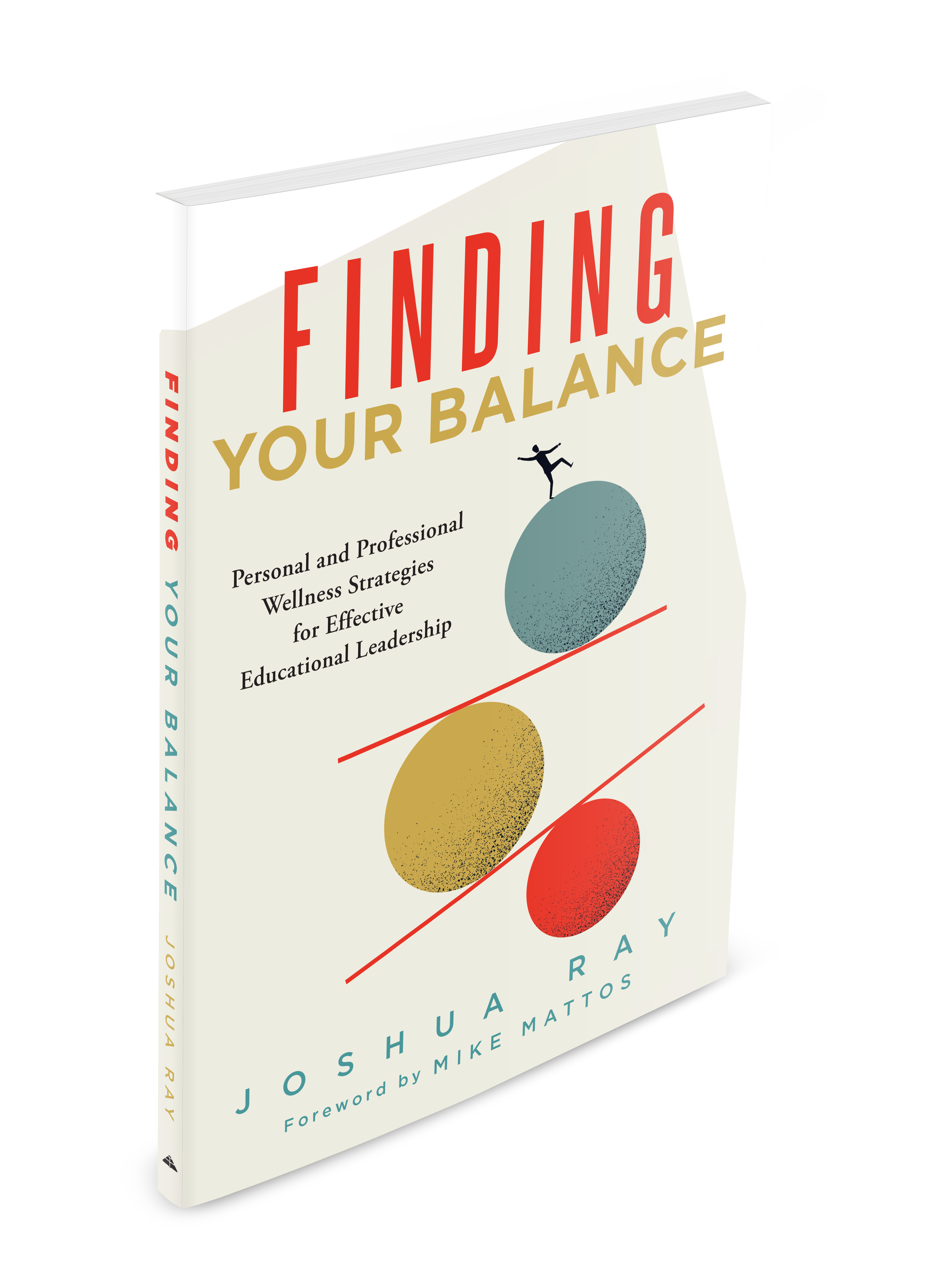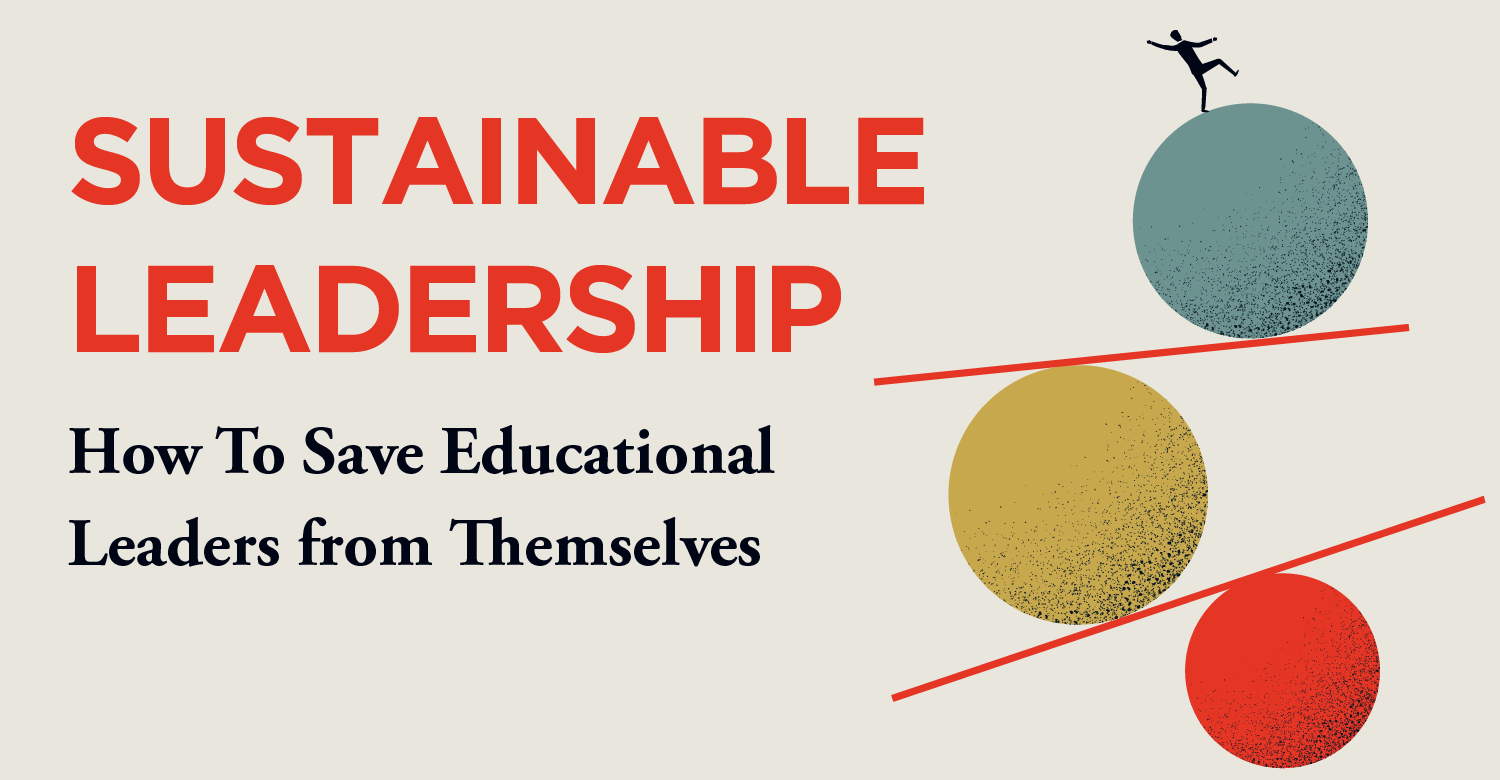 Great educational leaders can take care of anything—but they often forget that they need to take care of themselves, too. In order to support exceptional—and exceptionally long-lasting— leaders, we need to promote a culture of sustainable leadership. Discover the secrets of sustainable leadership and how to save educational leaders from themselves in this blog by Dr. Joshua Ray, author of Finding Your Balance.
Great educational leaders can take care of anything—but they often forget that they need to take care of themselves, too. In order to support exceptional—and exceptionally long-lasting— leaders, we need to promote a culture of sustainable leadership. Discover the secrets of sustainable leadership and how to save educational leaders from themselves in this blog by Dr. Joshua Ray, author of Finding Your Balance.
There’s a hidden crisis in educational leadership
The moment I opened her office door, I could feel something was off. The day had ended with gratitude and hopeful energy. I had just finished a professional learning session with her staff—easily one of the most engaged I’d experienced all year. But now, with the staff gone and the quiet of the empty auditorium settling in, the principal stood still, eyes wide, shoulders tense. “Do you have a little time to talk before you leave?” she asked.
What followed wasn’t a debrief. It was a confession. Through tears and whispered words, this brilliant, credentialed, celebrated leader admitted, “I don’t know if I can do this anymore.” It wasn’t a moment of weakness. It was a moment of truth.
I quickly learned she was far from alone. Schools across North America are struggling to attract and retain leaders. That said, we’re not losing them because they lack strength. Educational leaders are turning over at an alarming rate because many are depleting themselves until there’s nothing left to give those they lead.
This is not an isolated issue. It is a hidden crisis in educational leadership. Our profession has normalized exhaustion and glorified unsustainable sacrifice. Thankfully, there is a better way.
The hidden cost of exhaustive leadership
Educational leaders are among the most highly educated, skilled, and celebrated members of our profession. Yet many teachers across North America would need a moment to remember all the leaders they’ve worked with over the years. Sure, some leaders are promoted or change districts, but as I began talking with others in my own life, it became clear that many were crumbling under the weight of their roles.
Of course, most leaders don’t wake up one morning and suddenly feel burned out. It creeps in. One late-night email becomes a habit. One missed family dinner turns into three. We start telling ourselves it’s just a “season,” but the season stretches into months and years, taking an enormous toll.
In a study I conducted across my state, over 500 educational leaders shared painfully honest accounts of their lives: time away from loved ones, health issues, unrelenting stress, and constant guilt. Sadly, these stories weren’t outliers. They were the norm.
I lived the same experience. As a young principal, I was driven to make a difference. Our school was improving, our staff was thriving, and on paper, I was a resounding success. Privately, I was rationalizing no longer tucking my children into bed at night, unable to break my connection to my email inbox, and carrying an unyielding amount of professional and personal anxiety. I was receiving professional recognition, but at a personal cost I wasn’t sure how to keep paying.
Is your ambition worth the cost?
I had learned to justify the exhaustion in the eyes of my wife, who was effectively raising our two young sons on her own. I could even distract myself enough to forget the pain I felt every time one of my boys started crying when he heard, “Dad has to go back to work.” Ultimately for me, it would take three weeks of seizures and hospital visits before I sobered to the fact that my pace was hurting those I loved most and quite literally killing me.
Surely, I was alone in my bullheaded stubbornness, right? Sadly, I learned that was far from the case. As I spoke with other leaders, many paying similar physical and emotional tolls for their own professional drive, I discovered a predictable pattern that many of us experience. This kind of crushing imbalance often follows a progression that far too many leaders recognize only when the damage is already done.
The three stages of professional imbalance
I listened as many decorated leaders shared their own experiences, and to my surprise, I saw the same story, all too familiar to mine, playing out time and again. Different people. Different schools. But a frighteningly similar pattern.
Imposter syndrome
Despite their many degrees, certifications, and experiences, so many leaders were quietly carrying a crippling fear: What if I’m not good enough for this job? Every educator remembers being new and feeling inadequate, but the anonymity of our own classroom is very different from the microscope of leading an entire organization. As leaders, failure is not only scary, but also public, personal, and impacts many. Many leaders’ self-doubt is loud, and the pressure to prove ourselves is even louder.
Unsustainable effort
Under the weight of that self-doubt, many leaders decide they are far from the leader they aspire to be. While we cannot immediately become instructional experts, system wizards, or communication gurus, we can try to overcome our lack of skill with incredible effort. To quiet our own doubt, we work harder and harder. We say yes to everything. We stay late, wake up early, and try to be all things to all people. The most dangerous part of this approach is that it produces the results we long for. People begin to recognize our effort. It becomes easy to find our identity in service and hustle because, for the first time, many of us feel like we’re truly making a difference.

Self-sacrifice
Over time, our new identities as the hard-working, always-available problem-solvers begin to define us. Unknowingly, many leaders stop just doing the work and start becoming consumed by it. We convince ourselves that exhaustion is proof of our commitment. Tragically, the more people applaud us for always being available, the harder it becomes to set boundaries.
Do we choose to regain control of our lives and feel like failures in our role? Or do we excuse the strain we feel as the cost of being our best? Predictably, when facing this choice, most leaders choose those they lead even if it comes at the cost of themselves.
Sure, many leaders do this to themselves. However, it is a regular response to a system that asks too much, a culture that rewards overextension, and a profession of selfless educators who promote into leadership roles without a clear definition of success. Left alone, many leaders are breaking, creating constant turnover, and subjecting schools to a never-ending, revolving door of leadership.
Thankfully, it doesn’t have to be this way.
What sustainable leadership looks like
There’s a better path forward, one that allows leaders to keep doing the work they love without losing themselves along the way. It doesn’t require a complete overhaul, just a shift in how we define success and sustainability.
Balance is a leadership strategy
One of the most important conversations of my leadership life came when my mentor closed my office door and said, “This job isn’t worth what you’re spending on it.”
At the time, I was giving every part of myself to the role, but it was coming at the cost of what mattered most to me as a husband, father, friend, and person.
That conversation helped me begin drawing lines around my time, my energy, and my presence. I communicated my boundaries, practiced them intentionally, and called upon loved ones for accountability. It was the first time I realized this wasn’t selfish. Instead, it was the approach that would allow me to bring my best to those I was leading.
Leadership is all-consuming and taxing, but imbalance is not just a part of making the big bucks. The thought that you can be a great leader without being a whole human being is ridiculously impractical and a recipe for failure and burnout.
Basic well-being is not a luxury
Basic physical well-being isn’t a luxury. It’s a prerequisite for effective leadership.
Leaders don’t have time or energy for radical workout plans, aggressive diets, or shame-based regimens. Instead, our profession would benefit from recognizing that our most basic physical needs allow us to function at our best. The little things, many of which educational leaders learn to ignore, matter if we want to be our best.
Sleep deprivation and dehydration can impair brain function similarly to intoxication. Research by Daniel Kahneman has shown that something as simple as hunger can dramatically impact key decisions made by judges considering parole. If dehydration and sleepiness slow our brains and hunger diminishes our ability to engage in critical thinking, it’s easy to see how one could become significantly concerned by the number of leaders who cling to their coffee, don’t get enough sleep, and regularly can’t find time to eat during the school day.
It’s time to recognize that while many of us have convinced ourselves we’re just a little tired, thirsty, or hungry—we might actually be bringing a shell of ourselves to work each day. Our basic well-being matters not only to ourselves, but to those we lead as well.
Be the leader you want to be
People don’t accidentally rise to leadership roles. Every school leader demonstrated such skill in the classroom, in relationships, or in systems thinking that they were promoted to critically important positions of leadership. Why then do so many leaders spend their careers trying to overcome their perceived weaknesses instead of leaning into the gifts that got them the job in the first place?
Many spend their days like educational firefighters, running from problem to problem, never having the chance to realize their full leadership potential. Yes, life happens. Plans change. But great leaders are more than exhausted answers to every unplanned crisis. They know their strengths and find ways to bring their unique best to those they serve.
Leadership is a team sport
If each of us has a unique set of strengths and weaknesses, we can either play leader roulette, hoping the school’s needs match our strengths, or surround ourselves with those who are great where we are not.
Great leadership is a team sport. Sharing leadership isn’t weakness. It’s how we eliminate blind spots, broaden perspective, diversify skillsets, and multiply capacity.
Leaders who miss this not only set themselves up to fail, they also deny themselves the most rewarding element of leadership: growing it in others.
📰 To learn more about how to get the most out of your leadership team, check out this page by Education World.
The key to becoming our best as leaders
For those who have never shouldered the weight of leading an educational organization, it’s difficult to understand the cost, often self-imposed, that we pay to be our best. But here’s the truth: you can be great without losing yourself.
With practiced intentionality, we can protect what matters most, live well professionally and personally, lead in our strengths, and multiply the strengths of others to do what we never could alone.
This approach isn’t selfish. It’s the key to becoming our best as leaders.
Ultimately, our schools deserve our best, those we love deserve our best, and most importantly, we deserve our best.
So, go be well, be whole, and change lives for the better.
💻Looking for more free and practical strategies to avoid exhaustion and live your best life as an educator? Check out these two prerecorded webinars on avoiding burnout and attending to your own well-being:
About the educator
Joshua Ray, EdD, is an educational speaker and author who has led the Professional Learning Communities (PLC) at Work® process at the elementary, secondary, and district level. He is passionate about building healthy school cultures, the work of collaborative teams, systems of support, and educator well-being.






